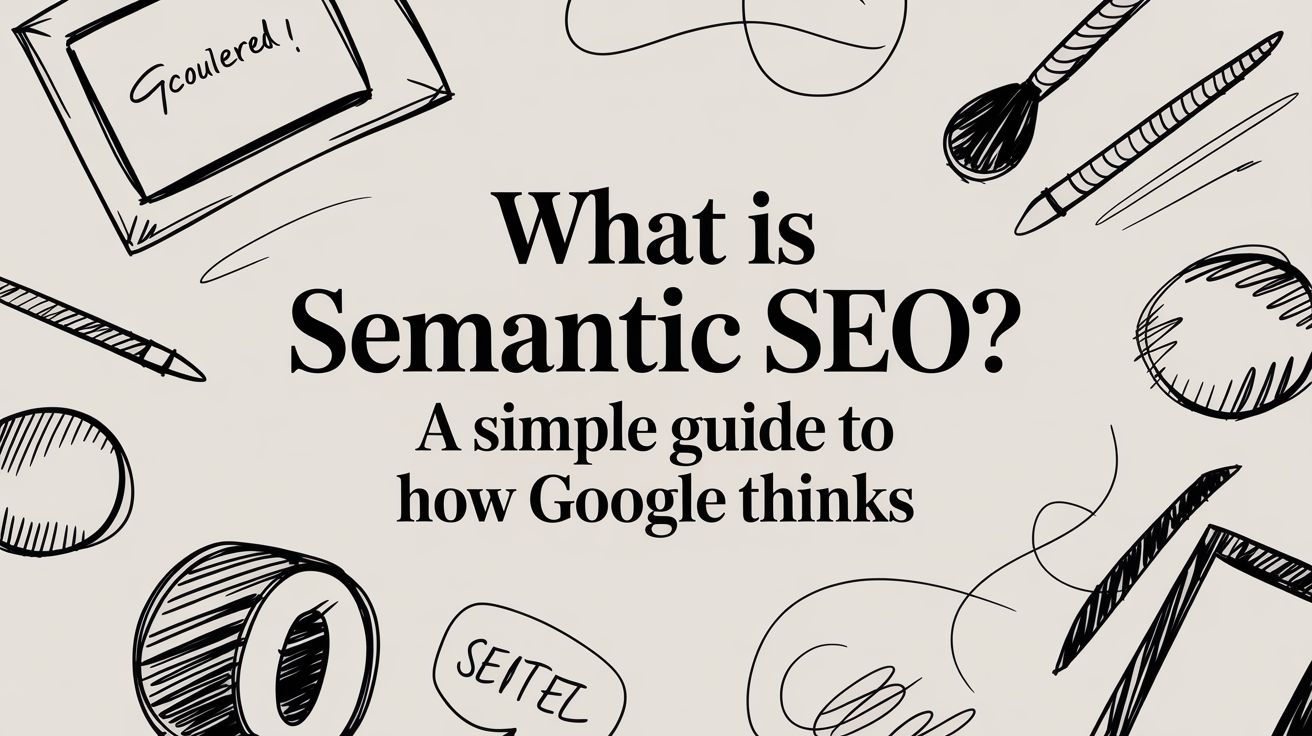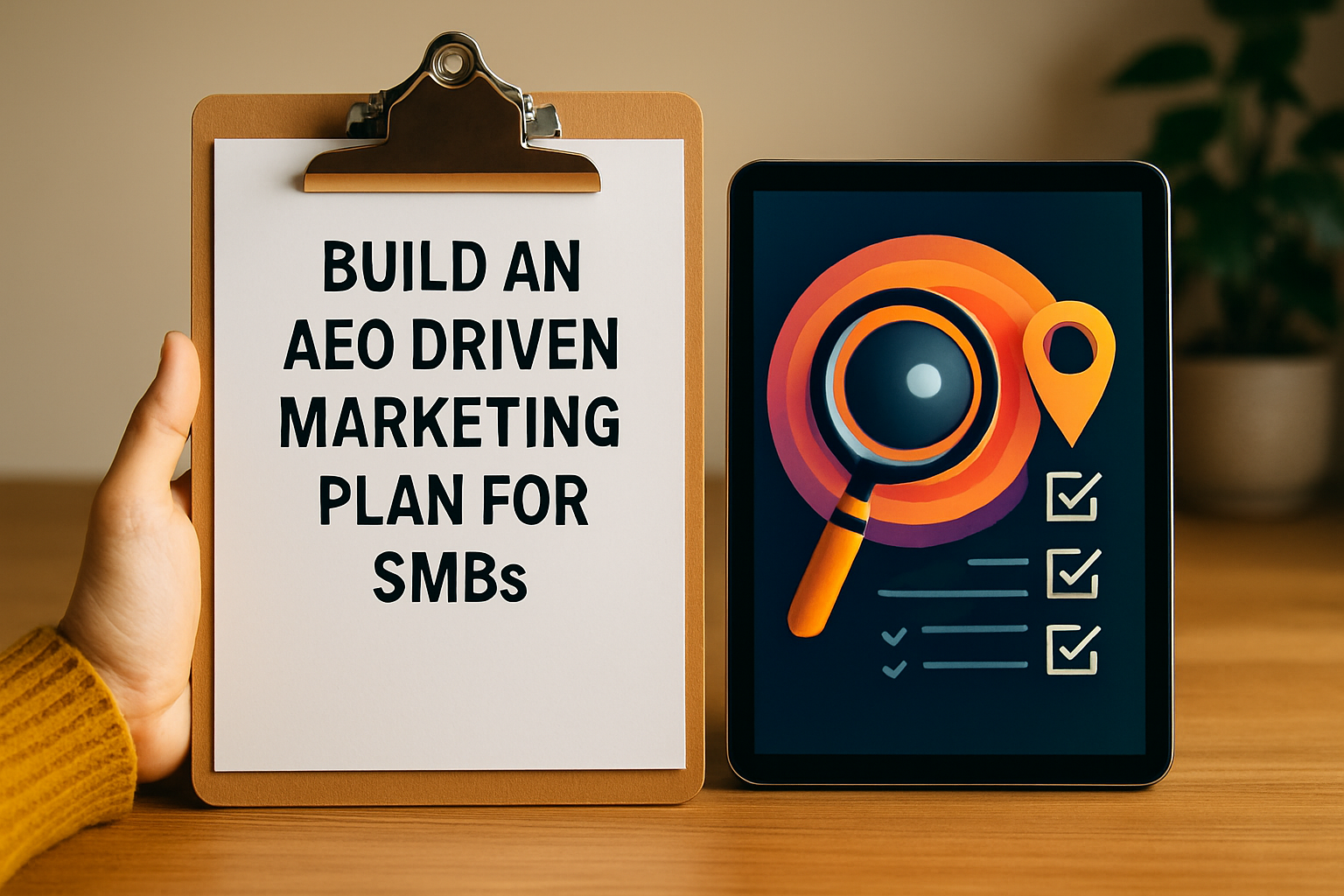What Is Semantic SEO? A Simple Guide to How Google Thinks

Imagine you ask a friend, "Hey, what's a good movie?"
An old, clunky search engine might just give you a list of every movie ever made. Not helpful!
But a smart friend (like Google now) would ask, "What kind of movie? Funny? Scary? Something for the whole family?"
That's semantic SEO! It's all about Google getting smart enough to understand what you really mean, not just the exact words you type. It’s about creating content that answers the real question behind the search.
Moving Beyond Simple Keywords
Way back in the day, getting on the first page of Google was a silly game. You'd just repeat a keyword like "best pizza in town" over and over and over. Seriously. The pages were terrible to read, but the robot search engine didn't know any better.
It was... not great.
Google realized that real people don't talk like robots. We ask messy questions. We have real problems! So, Google started to change. It wanted to be less like a dumb dictionary and more like a super-smart librarian.
A librarian doesn't just point you to the "C" section if you ask for a book on coffee. They might ask, "Are you a beginner? Looking for brewing methods or the history of coffee beans?" They get the context of your request to hand you the perfect resource. That's exactly what Google now aims to do.
Big updates with cool names like Hummingbird (in 2013) and RankBrain (in 2015) were like massive software upgrades for Google's brain. They taught it to understand how we actually talk and think. It was a huge leap!
What This Means for You
So, what is semantic SEO in real life? It means when you search for something like "best local plumber," Google knows you're not just looking for a name and number. It's already thinking about all the other stuff bouncing around in your head:
- Can I call them at 3 AM if a pipe bursts?
- Do my neighbors think they're any good?
- What do they actually do? (like, fix drains or install new toilets?)
- Will they even come to my neighborhood?
Google now connects all these related ideas to give you a complete and genuinely useful result. It’s no longer about tricking a system with keywords; it’s about providing real value by covering a topic from top to bottom.
Keyword SEO vs. Semantic SEO
To really get it, let's look at how the focus has changed from the old way to the new. This simple table shows the shift from just matching words to truly understanding what the user wants.
| Focus Area | Old SEO (Keywords) | Semantic SEO (Meaning) |
|---|---|---|
| Main Goal | Rank for one specific keyword. | Become the best answer for a whole topic. |
| Content Style | Often repetitive, narrow, and thin. | Comprehensive, in-depth, and genuinely helpful. |
| User Focus | Optimized for the search engine's robot. | Optimized for the human user's actual needs. |
Basically, semantic SEO is about being more human. When you focus on what someone really means, Google sees you as a helpful expert. And in return? You start showing up for way more questions that your future customers are asking every single day.
Why Semantic SEO Is a Game Changer
So, what’s the big deal with this shift from keywords to meaning? It’s pretty simple, actually. It’s the difference between shouting one word into a crowded room and having a helpful, in-depth conversation with your ideal customer.
When you focus on the whole topic, you build a mountain of trust. You’re not just answering one little question; you’re answering all the questions that pop up next. Suddenly, you’re not just another website. You become the person to ask.
Think of it like being the most trusted mechanic in town. When someone’s car makes a funny noise, they don’t just google “car repair.” They think of you first. This is how you build real authority that sticks.
Reach More People With Your Message
The old way of doing SEO was like fishing with a single hook. You’d try to catch people searching for one exact phrase. But what if they used slightly different words? Whoops, you missed them.
Semantic SEO is like fishing with a giant net. Because you’re covering a whole topic, your content starts showing up for hundreds, maybe thousands, of different but related searches.
Let's make it real:
- Someone might search for “how to fix a leaky faucet.”
- Another person might ask, “why is my kitchen sink dripping?”
- A third might look for the “cost to replace faucet washer.”
A single, amazing guide about fixing leaky faucets can answer all three. Bam! You’re suddenly visible to a much bigger group of people, all from one powerful piece of content. This builds a rock-solid foundation for your website that doesn't crumble every time Google changes something.
Attract Customers Who Are Ready to Act
This isn't just about getting more clicks. It's about getting the right clicks. When people land on your site and find that you’ve answered all their questions, they start to see you as a total pro.
This builds a powerful connection. These visitors aren't just casually browsing; they are actively looking for solutions and expertise. They are far more likely to trust you and become loyal clients because you've already proven you can solve their problems.
By focusing on what is semantic SEO and putting it to work, you pull in better visitors who are actually interested in what you do. They stick around longer, read more, and are so much closer to calling you up. It’s a true game changer for real, lasting growth.
The Three Pillars of Semantic SEO

Trying to figure out what is semantic SEO can feel like staring at a giant, confusing machine. But it's not! It all boils down to three main ideas. Once you get these, everything just clicks. This isn't about sneaky tricks; it's about understanding people, things, and what you're an expert in.
These three pillars work together like a team to show Google you're the real deal. They prove your content is a helpful answer, not just a page stuffed with words.
Let's break them down.
Pillar 1: Search Intent
First, and most important, is search intent. This is just a fancy way of asking, "What does this person actually want?" When someone types something into Google, they're on a mission. And that mission usually falls into one of three buckets:
- Informational Intent: They want to know something. Think "how to fix a leaky pipe" or "what are the signs of a bad water heater?" They're just learning.
- Transactional Intent: They're ready to buy or hire someone. Searches like "emergency plumber near me" or "cost to install a new faucet" mean business.
- Navigational Intent: They're just trying to get to a specific website, like searching for "[Your Company Name]."
Getting this right is everything. You wouldn't try to sell an emergency service to someone who just wants to know how a toilet works. You meet people where they are. That’s how you build trust.
Pillar 2: Entities
Next up: entities. Whoa, big word. But it's simple! An entity is just a real-world thing, place, or idea that Google understands. Like "New York City," "Apple," or even "plumbing." Google has a giant mental map of all these things and how they connect.
The classic example is the word "Jaguar." Are you looking for a car or a big cat?
The word alone is confusing. Google looks for other words around it—like "engine," "dealership," or "jungle," "prey"—to figure out what you mean. This is the magic that separates just matching words from actually understanding things.
When you write, you need to talk about related entities. If you’re a plumber writing about your services, mentioning things like "water heaters," "drain cleaning," and "sump pumps" gives Google the clues it needs to see you as a legit expert.
Pillar 3: Topical Authority
Finally, there’s topical authority. This is all about becoming the undisputed expert on a subject in Google’s eyes. You don't get there by writing one blog post. You get there by covering a topic from every possible angle, like you're writing the ultimate encyclopedia for your industry.
Think of it as building a library of helpfulness, one book (or page) at a time.
When you consistently create awesome, deep content that answers every question someone could have, Google starts to notice. It sees your website as a trustworthy source. Over time, that trust lifts all of your pages higher in the search results because Google knows you're the real deal.
How Google Connects the Dots with the Knowledge Graph
So how in the world did Google get so smart? How did it learn the difference between "Jaguar" the car and "Jaguar" the cat?
The secret is a giant system called the Knowledge Graph.
Think of it as Google's brain. It's not just a list of words. It's a huge, messy web of facts about all the things in the world and—this is the important part—how they're all connected to each other.
Every time you search, the Knowledge Graph is working like crazy behind the scenes. It's the engine that turns a jumble of information into organized knowledge. It connects billions of dots in the blink of an eye.
More Than Just Words a Web of Facts
Old search engines were pretty basic. You’d type "Paris," and it would look for pages with the word "Paris." Simple. But the Knowledge Graph thinks way bigger.
It doesn’t just see the letters P-A-R-I-S. It understands the thing that is Paris. It knows that:
- Paris is a city.
- That city is the capital of another thing, France.
- It's connected to other famous places, like the Eiffel Tower and the Louvre Museum.
- It’s tied to ideas like art, tourism, and history.
This is what lets Google understand what you're really asking. When you ask, "how tall is the Eiffel Tower," Google doesn't just look for those words. It pulls the answer right out of its brain because it knows what the Eiffel Tower is.
The Knowledge Graph is Google’s attempt to understand things the way we do—not as strings of text, but as a rich tapestry of interconnected concepts. It's what allows a search engine to give you answers, not just a list of links.
This web of facts is growing at an insane speed. A decade ago, it was tracking about 570 million things. Today, that number has exploded to roughly 800 billion facts about 8 billion things. You can find more insights on this evolution over at Niumatrix.com.
Why This Matters for Your Content
Understanding this big brain is a huge part of what is semantic SEO. When you write content, you're not just writing for people. You're also feeding information to Google.
Your job is to make it super easy for Google to connect the dots. When you write about "water heater repair," you should also talk about related stuff like "pilot lights," "leaky tanks," and "sediment buildup."
Each of those related terms helps Google place your content in the right spot in its massive web of knowledge. It confirms you're a real expert who gets the whole topic, not just one keyword. By linking ideas together clearly, you’re not just optimizing a webpage—you're teaching Google about your corner of the world.
Alright, enough of the "what." Let's get into the "how."
Moving from knowing the big ideas to actually doing them isn’t as hard as it sounds. It all starts with a simple change in how you think.
Instead of hunting for one perfect keyword, you need to start thinking in whole topics. The best way to do this? Get inside your customer's head. What are they really asking, from the moment they realize they have a problem all the way to when they're ready to pay someone to fix it?
For a minute, forget what sounds good to a computer. Just brainstorm every single question a real person would have about what you do.
Think in Topics, Not Just Keywords
Let’s say you’re a plumber. A customer whose water heater just went kaput doesn't just search for "water heater repair." Their brain is on fire with a dozen other questions. That's where your content ideas are hiding.
Your brainstorm list might look something like this:
- How do I even know if my water heater is broken?
- Is it cheaper to fix this thing or just get a new one?
- How long do these things even last?
- What are the signs of a leaking tank?
- Can I fix the pilot light myself, or will I blow up my house?
See what’s happening? You’re not just targeting one phrase. You're mapping out the entire problem your customer is facing. Every one of these questions is a golden ticket to create a super helpful piece of content.
Think of yourself as the most helpful person at the hardware store. Your job isn't just to sell a part; it's to walk the customer through their entire project, answering every little question they have along the way. That’s how you build real trust and become the obvious choice.
Organize Your Ideas into Topic Clusters
Once you have this big, messy list of questions, you can't just throw them up on your website randomly. You need a plan. This is where topic clusters come in, and they are the secret weapon for building authority.
A topic cluster is a simple but super smart way to organize your stuff. It has two main parts:
- The Pillar Page: This is your big, ultimate guide that covers a whole topic from top to bottom. For our plumber, this would be something like "The Ultimate Guide to Water Heaters." It would touch on everything—types, problems, tips, and costs.
- The Cluster Content: These are shorter articles that dive deep into one specific part of your big guide. These are your blog posts answering questions like "Repair vs. Replace: What to Do With Your Water Heater" or "5 Signs Your Water Heater Is About to Die."
Then, you link all the shorter articles back to your main guide. This sends a huge signal to Google that says, "Hey, we don't just know a little about water heaters; we are the absolute authority on this." This web of connected content is incredibly powerful.
Use Structured Data to Spoon-Feed Google
Finally, there’s a slightly more techy—but still totally doable—step called structured data. The easiest way to think about it is as a cheat sheet you give to Google.
You add a little bit of special code to your website that flat-out tells search engines what your content is about. For example, you can label your business name, address, phone number, and hours. If you have a frequently asked questions page, you can mark up the exact questions and answers.
This helps Google understand your content perfectly and can get you those cool "rich results" in search, like star ratings or question dropdowns right under your link. It takes away all the guesswork for the search engine, making it crystal clear what your page is about and why it's a great answer.
Common Questions About Semantic SEO
Once you start getting this stuff, a few questions always pop up. It's totally normal. Let's tackle them right now and clear up any confusion.
This little infographic breaks it down pretty well.
It's really just three steps: think in topics, organize those ideas, and then set up your content so Google gets it. Simple enough, right?
Now, for those nagging questions.
Are Keywords Completely Dead Now
No way! Keywords are still super important. Think of them as the starting point, not the finish line. You still need to know the words people are typing into Google. They’re the clues that lead you to the bigger topics you need to cover.
The big change is that you stop obsessing over just one keyword. Instead, you use that keyword to explore all the related questions and ideas that real people have. So yeah, keywords are still vital—they just have a new, smarter job.
How Long Will This Take to Work
This is more like planting a garden than flipping a switch. You're building real trust with Google by being super helpful, and that doesn't happen overnight. It’s a long-term plan, not a quick trick.
You’ll probably see small wins in a couple of months. But the real, "wow, this is working!" results usually start to show up after three to six months of doing it consistently.
The good news is that when you earn your spot this way, it’s much more stable. You’re building a foundation that Google trusts, which is way better than chasing quick tricks that disappear with the next update.
This approach creates a strong presence that pays off for years to come.
Do I Need Expensive Tools to Do This
Nope! You can get started without spending a penny. At its heart, this is all about knowing your customers. What questions do they ask you all day long on the phone or in emails? That's your goldmine.
For more ideas, just use the free tools Google gives you:
- "People Also Ask" boxes: These show you the exact questions people are searching for.
- Related Searches: Scroll to the bottom of the page. Google literally gives you a list of other popular searches.
- Google Autocomplete: Start typing a phrase in the search bar and see what Google suggests. It’s like a peek inside people's minds.
These free methods give you a ton of information. Sure, fancy paid tools can help you do more later, but the basic ideas don't cost anything to start using today.
Ready to stop guessing and start being seen as the definitive answer in your industry? The team at Authority Echo specializes in building this kind of deep, lasting authority. We turn your expertise into the "best answer" across search engines and AI, attracting qualified leads without the ad spend. Find out how well AI and search engines currently understand your brand with a free visibility audit.




